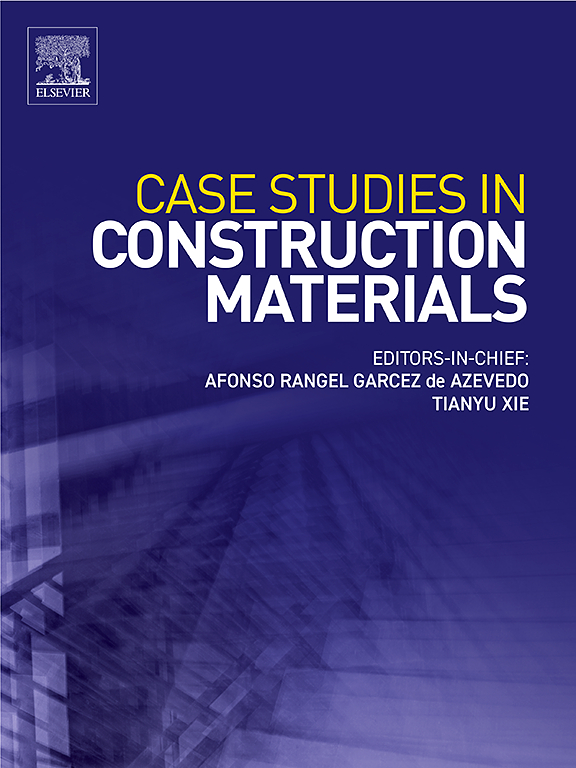Development of an innovative powder adhesive based on epoxy-polyester and lignin for production of particleboards
IF 6.6
2区 工程技术
Q1 CONSTRUCTION & BUILDING TECHNOLOGY
引用次数: 0
Abstract
This study presents the development of innovative particleboards bonded with a hybrid powder adhesive composed of epoxy-polyester resin and kraft lignin, aiming to eliminate formaldehyde and volatile organic compounds (VOCs) from the manufacturing process. While powdered epoxy-polyester adhesives are well established in the metal and automotive sectors, their application in wood composites remains largely unexplored and only limited research has explored their potential for particleboard production. Particleboards were manufactured using varying proportions of kraft lignin (0–100 %) to partially or fully replace the epoxy-polyester base. The optimal performance was observed with 20 % lignin substitution, where mechanical properties such as modulus of rupture (MOR = 8.3 MPa), modulus of elasticity (MOE = 1455 MPa), and internal bond (IB = 0.21 MPa) were comparable to or exceeded those of the control variant without lignin. Despite lower mechanical performance at high lignin ratios (≥80 %), 100 % lignin-based boards exhibited improved thermal stability and fire resistance, confirmed by TGA, DSC, and cone calorimetry. SEM analysis revealed that lignin contributed to good particle coverage and homogeneous bonding. These results demonstrate the feasibility of using kraft lignin in powder form as a binder or co-binder in wood-based composites. Such particleboards offer a promising alternative for applications in interior non-load-bearing construction and eco-friendly furniture manufacturing.
一种新型粉末胶粘剂的开发基于环氧聚酯和木质素生产刨花板
本研究介绍了一种新型的刨花板,该刨花板采用由环氧树脂-聚酯树脂和硫酸盐木质素组成的混合粉末粘合剂粘合,旨在消除制造过程中的甲醛和挥发性有机化合物(VOCs)。粉末状环氧-聚酯胶粘剂在金属和汽车行业已经很好地建立了,但它们在木材复合材料中的应用在很大程度上仍未被探索,只有有限的研究探索了它们在刨花板生产中的潜力。刨花板使用不同比例的硫酸盐木质素(0-100 %)来部分或完全取代环氧-聚酯基。当木质素取代量为20% %时,其性能最佳,其中断裂模量(MOR = 8.3 MPa)、弹性模量(MOE = 1455 MPa)和内键(IB = 0.21 MPa)等力学性能与不含木质素的对照型相当或超过。尽管高木质素比(≥80 %)的机械性能较低,但通过TGA, DSC和锥量热法证实,100 %木质素基板表现出更好的热稳定性和耐火性。SEM分析表明木质素有助于良好的颗粒覆盖和均匀的键合。这些结果表明,以粉末形式使用硫酸盐木质素作为木基复合材料的粘结剂或共粘结剂是可行的。这种刨花板为室内非承重建筑和环保家具制造提供了一个有前途的选择。
本文章由计算机程序翻译,如有差异,请以英文原文为准。
求助全文
约1分钟内获得全文
求助全文
来源期刊

Case Studies in Construction Materials
Multiple-
CiteScore
7.60
自引率
19.40%
发文量
842
审稿时长
63 days
期刊介绍:
Case Studies in Construction Materials provides a forum for the rapid publication of short, structured Case Studies on construction materials. In addition, the journal also publishes related Short Communications, Full length research article and Comprehensive review papers (by invitation).
The journal will provide an essential compendium of case studies for practicing engineers, designers, researchers and other practitioners who are interested in all aspects construction materials. The journal will publish new and novel case studies, but will also provide a forum for the publication of high quality descriptions of classic construction material problems and solutions.
 求助内容:
求助内容: 应助结果提醒方式:
应助结果提醒方式:


